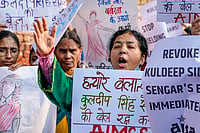Fiscal ’06 was the year of record credit growth. Bank credit to the commercial sector grew 27 per cent over in January ’06 compared to the same month last year. At the RBI’s third quarter monetary policy review meeting, deputy governor Rakesh Mohan said: "We haven’t seen such growth in the past 35 years. Credit has simply doubled in the last two years." Since the central bank has traditionally followed a conservative policy about exposures to credit risks and overheating of the economy, it has been tightening the forward rates over the past two years. Reverse repo rates have now gone up a full point to 5.5 per cent in the past 15 months, the highest in three years, even though the bank rate has stayed at 6 per cent since April 2003. As a result, both retail and corporate lending rates have shot up by over a couple of percentage points in this period. In the past few weeks, several banks have announced an increase in lending rates by 0.5-1 per cent for various segments.
The credit and liquidity growth was also reflected in the unusually high volume of market stabilisation operations (MSS) and the liquidity adjustment facility (LAF) used by the RBI in this fiscal. However, at year-end, concerns over both inflation and rise in global oil prices have been moderated and the central bank had earned a well-deserved pat on the back for its nifty money management. However, experts feel the banking system’s exposure concerns remain high. According to an economist in a multilateral institution, "The RBI governor is worried about credit quality; making it a little pricey is one way of forcing banks to appraise better, sorting out between the good and the bad borrowers. The central bank is also observing asset price inflation, stock and real estate, and seeking to dampen that a bit."
After a review of the flow of bank credit to the housing sector, particularly to land developers and builders, the RBI found that the majority of banks were not complying with the prescribed risk control mechanisms. On June 29, 2005, it issued a set of guidelines to banks on this. Banks were told to disclose their gross exposure to the real estate sector. A look at the figures till last fiscal partly explains RBI’s worries. The State Bank group doubled its lending to property sector in 2004-05, while public sector banks as a total gave 55 per cent more. Out of total lending by scheduled commercial banks to sensitive sectors like capital markets, property and some commodities, real estate loans came to Rs 24,691 crore in that year. Public sector banks accounted for 58 per cent of that, while the private banks gave 33 per cent.
Of course, non-performing assets or bad loans have declined across the banking spectrum. The setting up of the Asset Reconstruction Company also helped some banks transfer their bad assets to it. However, the recent stress on agriculture lending and the budget announcements on concessions to farmers have the potential to raise the risk element in priority sector lending.
In sum, fiscal 2005-06 has shown that so far banks have been able to fund the credit boom very well while improving their profits. But the increasing needs of a growing economy, even assuming that growth will consolidate and not go beyond eight per cent next fiscal, will require the banking system to be much stronger now. For one, they would need to be capitalised much more than they are at present because by this time next year, they must conform to Basel-II norms. The finance ministry announced major relaxation of norms last year so that banks could raise capital in innovative ways.
Then there are the changing circumstances—foreign exchange accretion has slowed down, and global economies are tightening. Higher interest rates could threaten corporate bottomlines and project viability, requiring higher caution by banks in lending. This could also lead to a consolidation by the bank. Lastly, financial sector liberalisations must continue to help Indian banking match global standards and manage an economy whose potential right now seems sky-high. The announcement of a committee on a roadmap for full capital convertibility of the rupee, along with a few more measures to allow India and Indians to use foreign capital, is one of the best news to come in this area in a long time.


























